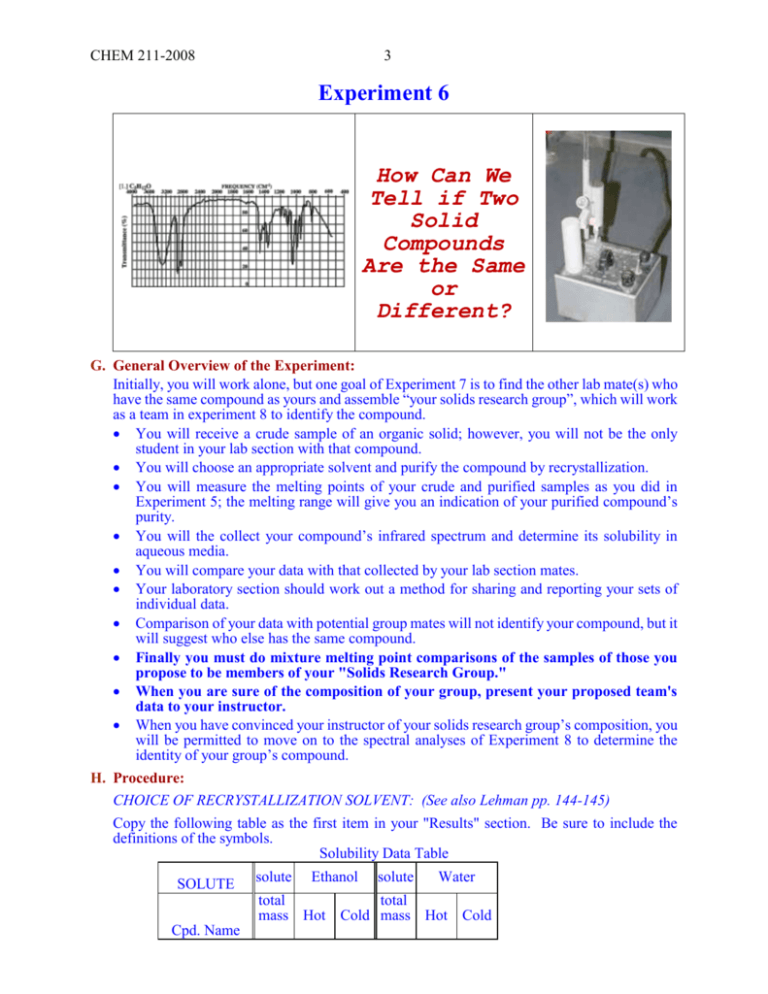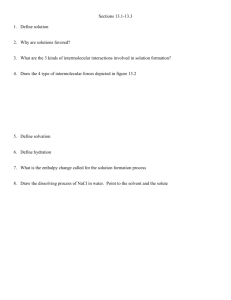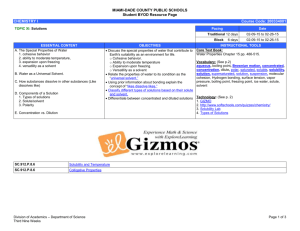Exploration 1
advertisement

CHEM 211-2008 3 Experiment 6 How Can We Tell if Two Solid Compounds Are the Same or Different? G. General Overview of the Experiment: Initially, you will work alone, but one goal of Experiment 7 is to find the other lab mate(s) who have the same compound as yours and assemble “your solids research group”, which will work as a team in experiment 8 to identify the compound. You will receive a crude sample of an organic solid; however, you will not be the only student in your lab section with that compound. You will choose an appropriate solvent and purify the compound by recrystallization. You will measure the melting points of your crude and purified samples as you did in Experiment 5; the melting range will give you an indication of your purified compound’s purity. You will the collect your compound’s infrared spectrum and determine its solubility in aqueous media. You will compare your data with that collected by your lab section mates. Your laboratory section should work out a method for sharing and reporting your sets of individual data. Comparison of your data with potential group mates will not identify your compound, but it will suggest who else has the same compound. Finally you must do mixture melting point comparisons of the samples of those you propose to be members of your "Solids Research Group." When you are sure of the composition of your group, present your proposed team's data to your instructor. When you have convinced your instructor of your solids research group’s composition, you will be permitted to move on to the spectral analyses of Experiment 8 to determine the identity of your group’s compound. H. Procedure: CHOICE OF RECRYSTALLIZATION SOLVENT: (See also Lehman pp. 144-145) Copy the following table as the first item in your "Results" section. Be sure to include the definitions of the symbols. Solubility Data Table SOLUTE Cpd. Name solute Ethanol solute Water total total mass Hot Cold mass Hot Cold CHEM 211 Experiment 6 4 Recrystallization & Solid Unknown (Unknown #) +++ ++ + - = = = = Symbols used to designate solubilities: soluble: all of the sample dissolved moderately soluble: more than half, but not all of the sample dissolved slightly soluble: less than half of the sample dissolved insoluble: no dissolution discerned Test the solubility of your unknown compound in each solvent. The solubility tests for the solute in both solvents must be done together side-by-side for comparison. Remember, as you fill in the table, that the results are a matter of degree, judged more by the trend than by the actual number of "+"s and "-"s. 1. Place about 1 ml of each solvent into a separate labeled test tube. 2. Add about 20 mg of solute, enough to cover the tip of a spatula, to each test tube and grind the solute with a stir rod to subdivide the particles as much as possible. 3. Observe the amount of solid remaining undissolved but do not draw conclusions about solubility yet. 4. If all of the solid dissolves at this point, add an additional 20 mg of the solute, grind the solid as before and note remaining undissolved solute. 5. Repeat additions until some solid remains undissolved at room temperature or until 100 mg has been added. 6. Record the total amount of solute added (total mass). 7. Heat the test tubes carefully with stirring in a hot water bath. Do not to allow the solvent to boil over or evaporate significantly (note the bp's of the solvents in your Table of Compounds compared to the temperature of the hot water bath). Even very soluble compounds may take several minutes to dissolve. 8. Take care to distinguish melting of the solute (two liquid layers) from dissolving (one liquid layer). A solute with a melting point (mp) below the hot water bath temperature or the bp of the solvent may melt yet not dissolve, or melt first and then dissolve. 9. Observe the amount of solid, if any, remaining in the hot solvent and record your estimate of the solubility in your table (Hot). 10. Finally, place the test tubes into an ice bath, allow them to cool thoroughly, and observe the amount of recrystallization, if any. 11. Record your estimate of the solubility in your table (Cold). NOTE: If any solute appears to be insoluble in a solvent both hot and cold, add an additional ml of solvent to the mixture and retest the solubility hot and cold. If your compound seems to be insoluble in both solvents or very soluble in both solvents, either too much or too little of the solute may have been added to all of the tubes. Consult your instructor. 12. Choose a suitable recrystallization solvent from the results of your solubility tests. If no single solvent seems to be suitable, consult with your instructor about using a mixed solvent system as described in Lehman pp. 143-144. 13. When you have chosen a solvent, consult with your instructor concerning your choice. Once you and your instructor have agreed on an appropriate solvent, proceed as described below. RECRYSTALLIZATION: So that you can determine melting points now or later, be sure to retain a sample of your crude unknown sample as indicated below. Dissolve the Sample: 14. Place 50 ml of your chosen solvent into a 100 ml beaker, cover it with a watch glass and heat it on a hot plate in a hood. 15. Weigh the sample of your unknown, fill two mp tubes with it for later mp determinations (See Experiment 5). 16. Add the rest of the solid to a 125 ml Erlenmeyer flask and add a boiling chip to the flask. Recrystallization & Solid Unknown 5 CHEM 211 Experiment 6 17. Place the flask containing your compound on the hot plate next to your beaker of hot solvent and immediately begin adding hot solvent to the compound a few mls at a time using a pipet. 18. The goal of the procedure is to add just enough hot solvent to dissolve all of the solid. 19. Add the solvent with discretion since if insoluble impurities are present, they will not dissolve and you may end up with too much solvent for an efficient recrystallization. If your solution contains undissolved solid, consult your instructor. 20. When solution is complete, measure the volume of the solvent remaining in the 100 ml beaker and determine the volume of solvent used. NOTE: More than 50 ml may be required to dissolve some compounds completely. Also, your compound may melt on the hot plate so be sure that you obtain a solution and not two separate liquid layers. Allow the solid to crystallize: 21. Cover the solution with a watch glass and carefully set it aside to cool slowly and recrystallize until it reaches room temperature. 22. After the solution has cooled to room temperature (When it no longer feels warm to the touch.), cool it further in an ice bath. 23. While the solution is cooling set up a vacuum filtration apparatus as described in Figure C4 of Lehman on p. 66, but without the filter trap. Be sure to secure the filter flask with a clamp. 24. Cool ~20 mL of your recrystallizing solvent in your ice bath for use in washing your crystals after they are filtered. Collect the solid: 25. When the solution has reached ice bath temperature, pre-moisten the filter paper in your prepared Büchner funnel with your recrystallization solvent, turn the suction on, then scrape the crystals off the walls of the flask, swirl the mixture and pour it into the funnel. 26. As soon as the bulk of the liquid has been sucked through the filter, disconnect the suction hose. At this point the crystals are wet with mother liquor, which contains dissolved soluble impurities. If the suction continues, the air drawn through the solid will evaporate the solvent from the mother liquor, depositing the impurities on the surface of the recovered crystals. 27. If crystals remain in the recrystallization flask, pour the mother liquor from the filtration flask back into the recrystallization flask to aid in completing the transfer of crystals to the funnel. Wash the product: 28. Once all of your crystals have been transferred to the funnel, remove the suction hose from the flask to release the vacuum and pour enough ice cold fresh solvent into the Büchner funnel to just cover the crystals. 29. With a small spatula, gently but quickly, mix the crystals with the solvent, taking care to avoid tearing the underlying filter paper. 30. Immediately reattach the suction hose to draw the liquid quickly away. 31. Repeat this process, if necessary, keeping in mind that each wash removes additional adsorbed impurities, but also dissolves some of your compound, reducing your yield. 32. Continue the suction for an additional 5 min. to draw air through the washed crystals to aid drying by removing as much excess solvent as possible. Dry the product: 33. Transfer the filter paper and crystals to a watch glass. 34. Remove the filter paper, grind the crystals to small size and allow them to dry until the end of the period. 35. Then store the product in a loosely covered container or on a watch glass covered with an inverted beaker until the next period. Characterize the product: 36. When the crystals are completely dry, determine the mp of your recrystallized compound and the crude sample of the compound side-by-side and record the values. CHEM 211 Experiment 6 6 Recrystallization & Solid Unknown 37. Weigh the purified compound. Record the weight in your Results Section and calculate the % recovery of your compound from the recrystallization. Recrystallization & Solid Unknown 7 CHEM 211 Experiment 6 ACID-BASE SOLUBILITY TESTS FOR CLASSIFICATION OF UNKNOWN COMPOUNDS Solubility test with water 1. Add ~1 ml of water (measure with your graduated plastic pipet) to one of your smallest size test tubes. 2. Add ~ 20 mg of your solid to the test tube and stir the mixture vigorously with a stir rod. 3. If all of the solid dissolves, continue to add the solid ~20 mg at a time with stirring until some solid remains undissolved or until 100 mg have been added. 4. If 100 mg of the solid completely dissolve, test the pH of the solution and that of a sample of the water used for solubility tests with pH paper, to judge whether the compound is acidic, basic or neutral; omit the base and acid solubility tests. 5. If less than 100 mg of the solid dissolves, judge it to be slightly soluble (20 - 80 mg dissolved), or insoluble (no apparent dissolving occurred), and continue on with the base and acid solubility tests. 6. Use 1M NaOH to test the compound's solubility in basic solution; note any difference in solubility compared with that in water. 7. Use 1M HCl to test your compound’s solubility in acid; note any difference in solubility compared with that in water. When large organic compounds react with acid or base they gain a single positive or negative charge (See Lab Manual Appendix A-1). The addition of a charge to a large molecule will usually increase its solubility in water, but may not make it completely soluble under the test conditions. Thus, it is important to do all three solubility tests sequentially side-by-side and to use identical amounts of solute (unknown solid) and solvent. Look for changes in solubility as the solvent medium changes. INFRARED SPECTROSCOPY You will be personally instructed in the technique that we will use for obtaining the IR spectrum of your liquid unknown but the general procedure is: 1. Assure that the sample holder is empty and clean. 2. Acquire a background spectrum. 3. Put a sample of your solid on the sample holder. 4. Lower the piston to depress the sample against the cell’s diamond window. 5. Acquire your sample spectrum and adjust the display for printing. 6. Save the spectrum with a specific file name. 7. Print the sample spectrum. 8. Record your IR spectrum file name on the spectrum print out and in your notebook. 9. Place the IR spectrum in the appropriate section of your Data Binder. Make sure it is properly referenced in your notebook (see Lab Manual p. 22). Comparison of your IR spectrum with those collected by your classmates will help you to eliminate lab mates with different unknown compounds. LOCATE THE MEMBERS OF YOUR SOLIDS RESEARCH TEAM. In trying to find the other members of the class who have your unknown, consider: 1. What are the properties of your substance? 2. How do these properties compare with those reported elsewhere in the class? 3. What constitutes a valid comparison? How close must properties of two compounds match to assure that the compounds are identical? 4. When you believe that you have identified those in your lab section with your compound, do appropriate mixture mp determinations to verify that all samples contain the same compound. PRESENT YOUR DATA AND CONCLUSIONS ON THE MEMBERS OF YOUR "SOLIDS RESEARCH TEAM" TO YOUR INSTRUCTOR.





